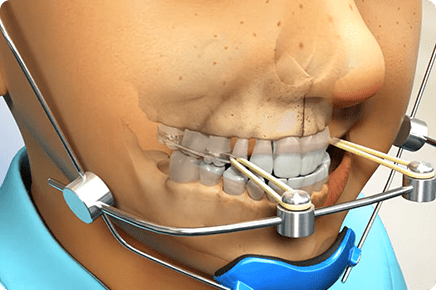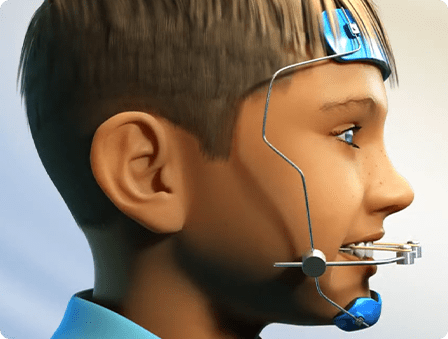FACEMASK CORRECTING UNDERBITE DEMO
FACEMASK CORRECTING UNDERBITE DEMO
Reverse Pull Headgear Correcting Underbite in Children
Table Of Contents:
- How To Fix An Underbite In A Child?
- Underbite Treatment Options Incorporate:
- Defining reverse pull headgear: What is it?
- When is the best time to seek treatment?
- How to wear a reverse pull headgear?
- What if my reverse pull headgear causes mouth irritation?
- How will I get used to my reverse pull headgear? Will I feel sore?
- What if my reverse pull headgear loosens?
- Can I skip days in wearing my reverse pull headgear?
- What if my chin is irritated from wearing a reverse pull headgear?
- Are there any additional side effects to wearing reverse pull headgear?
How To Fix An Underbite In A Child?
Is your child suffering from an underbite? Don’t wait too long, consult your family orthodontist or a nearby orthodontist to get a precise diagnosis and treatment options. Only a skilled professional helps determine the most suitable treatment option depending on the severity of the underbite and your kids’ age. When it comes to the ideal orthodontic treatment, a reverse pull headgear plays a significant role in it. True, today there is a variety of correctional orthodontic tools which help fix teeth, moving jaw mask and related issues. However, what makes a reverse pull headgear different from the rest is its early age effects. In case you know little on what a reverse pull headgear is and what it is used for, read on below to learn more.
Underbite Treatment Options Incorporate:
Braces: It is the commonest way to fix an underlying condition of an underbite. Maybe, your child becomes self-conscious about their appearance after wearing them. If they feel embarrassed wearing metal braces, they can choose clear braces as they are less noticeable than them.
Appliances: Your orthodontist can customize or personalize special appliances fitting your child’s mouth. These can be headgear, expanders, and retainers.
Surgery: Rarely, your child may suffer from severe underbite requiring surgery to fix it. Surgical treatment is the last option when your dentist finds no other way to treat it effectively.
According to reliable sources, only ten to fifteen percent of teens have such intensive malocclusion requiring surgical treatment.
Primarily, you can be shocked to see your baby’s underbite for the first time. It is a vital fact to know that every child requires following oral hygiene rules strictly to maintain child mouth clean and healthy. Also, educate your child about maintaining oral health with the help of pediatric professionals.
Defining reverse pull headgear What is it
A reverse-pull headgear is an orthodontic appliance which is used in pre-teen years to mend a variety of conditions. Mostly, a reverse pull headgear focuses on increasing jaw mobility, thus possibly avoiding surgery altogether. As one of the most recommended treatments during childhood, wearing a reverse pull headgear is simply a ‘must’.
The device itself attaches on the upper jaw and patients literally wear it as a facemask. This extraoral device uses rubber bands, secured on already known orthodontic tools. Such are, for instance, braces, splints, or expanders. The main goal is to drag the upper jaw forward, by putting the elastics (rubber bands) to work. Patients normally wear the appliance throughout the majority of their day, or from 12-18 hours daily. This duration allows a greater impact of the device and a significant improvement in the upper jaw placement.


When is the best time to seek treatment?
Various studies worldwide agree that wearing a reverse pull headgear is a medical necessity for some patients. As the appliance is used on children, it is good to start thinking about the best time to visit your orthodontist. Many experts suggest that it is best to seek reverse pull headgear treatment is between the ages of 8-14
How to wear a reverse pull headgear?
After your orthodontist sets up a diagnosis and does an initial preparation, he or she will install the reverse pull headgear. With that, there is an initial expansion the moving jaw mask, supported by a set of rubber bands. It is crucial the child wears the facemask and rubber bands daily. Children can also wear the appliance to school and ought to wear it to bed, too. The appliance itself will immediately start working on applying pressure on the rubber bands. This pressure will later lead to upper jaw bone growth, which ultimately pulls the jaw forward. Make sure to change the elastics before putting the headgear on daily.
Please know that wearing a reverse pull headgear can be initially uncomfortable, but the discomfort only lasts a few days. Should you feel any pain or constant aches, don’t hesitate to schedule a visit with your orthodontist near me. Below, we have answered some of the most popular questions on wearing a reverse pull headgear:
What if my reverse pull headgear causes mouth irritation?
If any irritation occurs at all, it would usually be at the corners of your mouth. Keep in mind that your headgear has elastics attached to it. These rubber bands are either attached to the headgear or are placed in
How will I get used to my reverse pull headgear? Will I feel sore?
You can expect a mild discomfort in the first few days after wearing the appliance. You might also struggle with sleeping positions, but it does not take long to get accustomed to the device.
What if my reverse pull headgear loosens?
If the appliance suddenly seems wider than normal, take the headgear off and make an appointment with your local orthodontist.
Can I skip days in wearing my reverse pull headgear?
Unless recommended by your orthodontist, it is best to wear the device as much as possible. In some cases, the device is worn from 12-14 hours a day, without taking it off. This is more than essential, as it shows the best and quickest effects. Skipping days in wearing the gear is not advised, as it brings the treatment back to the start. Avoiding to wear the appliance can also result in soreness and jaw strain.

What if my chin is irritated from wearing a reverse pull headgear?
Each device comes with a set of pads which help protect the chin better. Make sure all pads n your appliance are dried off and clean. If you notice the pads are losing their effect, consult your orthodontist to get them replaced. In some patients, applying extra padding worked as well. Therefore, feel free to use an additional cloth, towel, gauze, or even shoe insole to make you more comfortable. Also, you can allow the pads to breathe even more by covering them with cotton.
Are there any additional side effects to wearing reverse pull headgear?
While there aren’t many side-effects to wearing a reverse pull headgear, you might experience sleeping problems or muscle contractions. Sleeping problems mainly occur as the device is rather new to the face and odd to position. If you are not a back sleeper, you will need some time to get used to sleeping with the device. The appliance’s strength can shape the airways in children as well. This problem normally occurs when the child is asleep, so you won’t notice them during the day. If the appliance interfered with the airways, it can lead to obstructive sleep apnoea. If the patient is behaving more tired than usual, visit your orthodontist for additional headgear adjustments.
Another side-effect you can experience while wearing a reverse pull headgear is muscular tension. The jaw and facial muscles engage in plenty of activity when the appliance is active. When a reverse pull headgear works, it uses pulling as its force. Pulling can later cause muscle tension, and milder neck muscles cramping. Finally, as a result of actively wearing the facemask, a child can experience loss of focus and confusion. With reverse-pull headgears, this confusion mostly happens right before it’s time to take the appliance off. If you have any other concerns or questions, don’t hesitate to pay your orthodontist a visit at once!
AMERICA'S TOP DENTIST
How does a facemask look like?
It has a big metal bar that is fixed to a pad for the forehead and a chin cup and it acts as a framework for maintaining support to these facial features. The forehead pad and chin cup should be adjusted to suit the height of wearer’s face. At the mouth level, there are hooks attached to the bar to enable the rubber bands to be fastened to upper braces. These rubber bands’ role is to exert a pulling force on the upper jaw and teeth, causing them to move forward. In most situations, an orthodontist hooks these elastic bands onto an upper jaw widening gadget; the upper jaw tends to move forward easily when it is being widened as well.
To produce great results, a face mask with Hyrax should be attached for fourteen hours every day. But, if this mask is worn longer than this period, it is likely to correct the jaw issue in question soon enough. A child should wear this device for six to twelve months depending on the severity of their problem. One thing to note is that even if the face mask can correct a certain problem, a child’s jaw may continue to grow poorly yet again. This can even lead to a jaw surgery later on. An orthopedic facemask is popular though, when a child suffers from class III malocclusions that affect the maxilla (upper jaw).
Why treat class III bad bites at an early age?
Class III malocclusions (underbite) do not only ruin a child’s smile but also its ability to chew food properly. These are some of the basic reasons why class III bad bites should be treated as early as possible. If this is done, the following benefits can be attained:
- Permanent changes to bone and enamel (hard tissues) and gingival ligament (soft tissues) can be prevented.
- The skeletal discrepancy between the upper jaw and lower jaw will be corrected. This will boost jaw growth, enabling a normal intermaxillary relationship.
- Occlusal function will be enhanced. A forward shift on the lower jaw due to teeth affected by crossbites leads to further lengthening. But, when a face mask with Hyrax is used, it moves the upper jaw forward. This corrects the lower jaw forward shift, gets rid of skeletal discrepancy and leads to normal jaw growth pattern from that point onward.
- It makes the next major treatment (Phase 2 orthodontic treatment) easier when a child enters adolescence. It does so by reducing the risk of the need to do an orthognathic surgery later on and if it’s necessary, making it simpler.
- To boost a child’s psychological growth by making the face more attractive.
When is the best time to take a child to have a face mask?
Orthodontists have identified three stages: 4 to 7 years, 7 to 10 years and 10 to 14 years. If a child is taken to the dentist when they are 7 to 10 years of age, it has a bigger chance of wearing the face mask with Hyrax for fewer hours each day than older kids.
Learn More about other orthodontic appliances that can help with bite problems at https://ivanovortho.com/teeth-straightening-types-of-orthodontic-appliances/
FIVE-STAR PATIENT TESTIMONIALS









